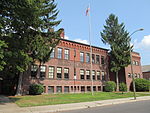WHLL
WHLL (1450 AM) – branded as Nueva 98.1 – is a commercial radio station broadcasting a Spanish-language latin pop format licensed to Springfield, Massachusetts. Owned by Audacy, Inc., the station serves the Springfield metropolitan area; and the Pioneer Valley of Western Massachusetts. The WHLL studios are located at the Naismith Memorial Basketball Hall of Fame in Springfield, alongside sister stations WMAS-FM and WWEI, while the station transmitter, shared with WMAS-FM, resides in Springfield's Brightwood neighborhood. In addition to a standard analog transmission, WHLL simulcasts over low-power analog Springfield translator W251CT (98.1 FM) and on the second HD Radio channel of WMAS-FM, and streams online via Audacy.
Excerpt from the Wikipedia article WHLL (License: CC BY-SA 3.0, Authors).WHLL
Avocado Street, Springfield
Geographical coordinates (GPS) Address Nearby Places Show on map
Geographical coordinates (GPS)
| Latitude | Longitude |
|---|---|
| N 42.109261111111 ° | E -72.610644444444 ° |
Address
Avocado Street
01107 Springfield
Massachusetts, United States
Open on Google Maps







